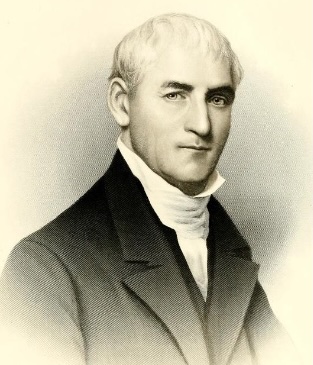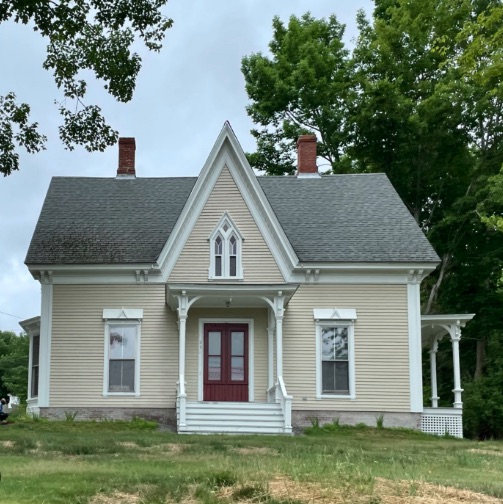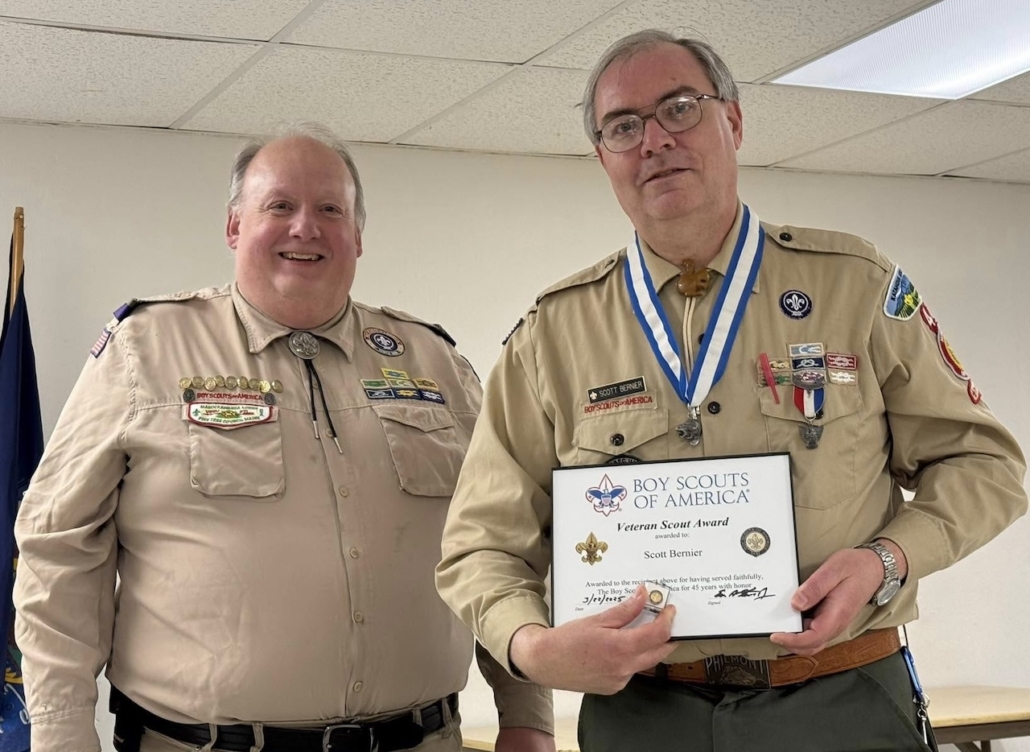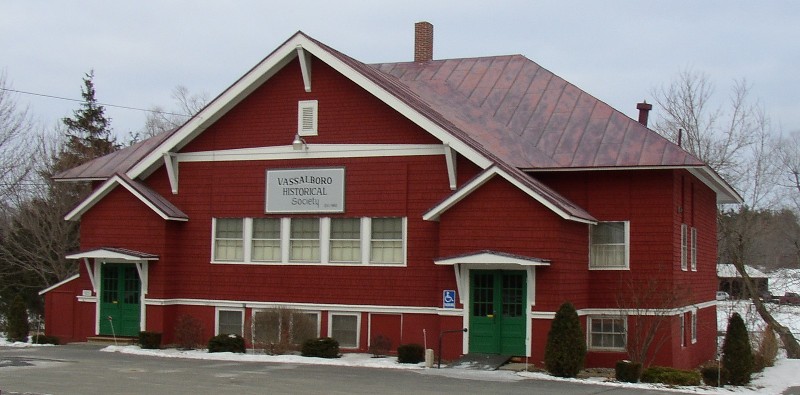One of the chapters in Henry Kingsbury’s 1892 Kennebec County history is about the courts. The next chapter is titled The Kennebec Bar and names members of the Kennebec Bar who practiced as lawyers and/or held judgeships or other legal positions.
The following articles in this subseries will talk about the legal structure from the 1600s, when Maine was a province of Massachusetts and both were under British rule, through the 1800s; and about some of the prominent men – there was an absence of women in the profession in those days – who made the law work.
* * * * * *

Judge William Penn Whitehouse
The chapter on courts in Kingsbury’s history was written by Vassalboro native William Penn Whitehouse, at the time serving on Maine’s Supreme Judicial Court (more about Whitehouse later in the subseries). He began by defining the role of the judiciary.
“The judiciary,” he wrote, “is the conservative force that maintains a just and stable relation between other branches of the government. It is the indispensable balance-wheel of every enduring political system.”
Whitehouse did not talk about the Massachusetts judicial system being derived from the British, perhaps because he assumed everybody knew that. He began by pointing out the mingling of Maine’s system with Massachusetts’ after Massachusetts bought southern Maine in 1677 from the grandson of Sir Ferdinando Gorges, who had ruled it from 1622 to his death in 1647.
Whitehouse found records of a 1636 court in Saco, said to have been the first legally created legal tribunal in Maine. After 1639, Gorges’ executive council acted as a court, Whitehouse said.
Gorges’ part of Maine also had “an inferior court in each section of the province”; and “commissioners corresponding to the modern trial justices were appointed in each town for the trial of small cases, with jurisdiction limited to forty shillings.”
Gorges’ jurisdiction did not include the sparsely-populated Kennebec Valley, Whitehouse wrote. This area belonged to the Plymouth Colony from 1640 until the Duke of York took it over in the early 1660s. In 1686, after the Duke became King James II (who reigned from Feb. 6, 1685, until he was overthrown effective Feb. 12, 1689), he transferred “the port and county of Pemaquid” (and presumably its upriver inland territory) to Massachusetts, Whitehouse said.
In 1691, Massachusetts got a new royal charter that united the various parts of Maine. The Massachusetts legislature promptly enacted its own Charter of 1691, setting out British-based legal principles and establishing four levels of courts that Whitehouse said remained virtually unchanged for 50 years.
The superior court for Maine cases was held in Massachusetts until 1699, Whitehouse wrote. From 1699 to 1760, one annual term was held in Maine – he did not say where.
In 1760, Maine was divided into Cumberland and Lincoln counties, with Lincoln including what became Kennebec in February 1799. In 1761, the Kennebec proprietors, successors to the Plymouth Colony, built what is now the historic Pownalborough Courthouse on the east bank of the Kennebec River, in present-day Dresden.
Whitehouse said Lincoln County’s first superior court meeting was not until 1786. The first term at Hallowell began July 8, 1794, before Augusta separated from its southern neighbor in February 1797.
Court was held “in a church prepared for the occasion,” Whitehouse wrote: the 1790 courthouse in Market Square, near the Kennebec, was too small. The three judges “were attended by three sheriffs wearing cocked hats and carrying swords, each with his long white staff of office.” The officials attracted a large audience as they marched to the church to the beat of a drum, followed by members of the bar.
In 1799, Augusta became Kennebec County’s shire town and hosted an annual term of the Massachusetts Superior Court, apparently until Maine became a state in 1820. Depending on the nature of the trial, sometimes all three judges presided, sometimes only one.
Before 1792, Whitehouse wrote, they “appeared on the bench in robes and wigs, the robes being of black silk in the summer and of scarlet cloth in the winter.”
* * * * * *
Both William D. Williamson, in his 1832 Maine history, and Louis Hatch, in his 1919 Maine history, listed the courts being headquartered in Boston as one cause of the movement for separation from Massachusetts. Both cited a January 1786 list of “evils and grievances” from the second convention called to discuss separation (the first, in October 1785, attracted representatives from so few towns that delegates called a better-publicized second gathering).
The fourth problem on the convention’s list was that the Supreme Judicial Court could not administer justice in Maine as promptly as required. With the clerk’s office and court records in Boston, “legal process and lawsuits must be attended with additional costs, perplexities and delays of justice,” Williamson wrote.
He added a footnote: “This evil continued till the year 1798.”
Although no action resulted from the 1786 convention, it was a step in the movement that resulted in Maine statehood in March 1820. More immediately, Williamson and Hatch said, it led Massachusetts authorities to revamp some of the laws to which Maine people objected; to build two new major roads; and to begin holding court sessions in the province.
In 1786, Hatch wrote, the Massachusetts Supreme Court held its first term in Pownalborough, plus an additional term of the lower court of Common Pleas and Sessions (see below). Beginning in March 1787, “the lower courts” also held one term annually in Hallowell (and one in Waldoborough); and the Massachusetts secretary of state was ordered to publish Massachusetts laws in the Falmouth Gazette, Maine’s first newspaper (founded in 1784).
* * * * * *
By 1819, Maine residents were so strongly (though never unanimously) in favor of independence that the Massachusetts legislature passed a bill authorizing a Maine vote on separation. The vote was duly held on the fourth Monday in July, 1819 (July 26). On the fourth Monday in August (Aug. 23), Massachusetts Governor John Brooks announced separation had been approved, 17,091 votes in favor to 7,132 against.
Once Maine became a state, the next step was to organize its government. A constitutional convention met Oct. 11, 1819, in Portland.

Judge Daniel Cony
Hatch said, “By unanimous consent, Judge Daniel Cony, of Augusta, was requested to take the chair” for preliminary steps, though he was quickly replaced by William King, of Bath, as chair of the body.
(King later became Maine’s first governor. More on Judge Cony later in this subseries.)
Williamson wrote that a 33-man subcommittee drafted a constitution based on Massachusetts’. The convention approved it, called for town meetings to approve or reject it on the first Monday in December (Dec. 6); and adjourned Oct. 29, Williamson said. A majority of towns approved.
The constitution described the state government, citizens’ rights and other typical topics.
The section on the judiciary in Maine’s current constitution says: “The judicial power of this State shall be vested in a Supreme Judicial Court, and such other courts as the Legislature shall from time to time establish.” The 1820 state constitution differed by one word, according to Whitehouse: it began “The judicial power of the state….”
Whitehouse cited a June 24, 1820, law establishing a three-justice supreme judicial court and defining its powers. In following years, the legislature required the court to meet at least once a year in most of Maine’s counties, with Kennebec County’s term scheduled in May, in Augusta.
From 1820 to 1839, Wikipedia says, Maine justices were appointed for life, with a mandatory retirement age of 70. Whitehouse said the number of justices was increased to four in 1847 and seven in 1852.
By 1892, Whitehouse wrote, the court consisted of a chief justice and seven associate justices, appointed by the governor for seven-year terms. (Currently, the court consists of a chief justice and six associate justices.)
The Wikipedia writer commented that unlike most other states’ top courts, the Maine court was and is not headquartered in the state capital. The reason is partly that the 1829 Kennebec County courthouse lacked a large enough courtroom. Nonetheless, the writer said, the court met there from 1830 to 1970, when it moved permanently to the Cumberland County courthouse, in Portland.
Whitehouse listed four 19th-century Maine Supreme Court justices who came from Augusta:
— Nathan Weston, appointed an associate justice July 1, 1820, and chief justice from Oct. 22, 1834 to Oct. 21, 1841;
— Richard Drury Rice, associate justice from May 11, 1852 to his resignation Dec. 1, 1863;
— Artemas Libbey or Libby, appointed from April 24, 1875, to April 24, 1882; reappointed Jan. 11, 1883, and Jan. 10, 1890; served until his death March 15, 1894; and
— William Penn Whitehouse, appointed associate justice April 15, 1890; reappointed April 24, 1897, April 5, 1904 and April 13, 1911; appointed chief justice July 26, 1911; resigned April 8, 1913.
Another important state court official, Whitehouse wrote, was the Reporter of Decisions, the person responsible for compiling the annual decisions of the court when it is sitting as the Maine Law Court (appellate court). Reporters from Kennebec County to 1892 were Asa Redington, from Augusta (1850-1854) and Solymon Heath, from Waterville (1854-1856).
* * * * * *
Below the provincial and later state supreme court was the court of common pleas. Whitehouse wrote that such a court was “organized for each county under the province charter of 1692.”
(Wikipedia says the court of common pleas was an early British form of lower court for hearing cases that did not involve the king. These courts are mostly obsolete, though four U.S. states still have trial courts so titled, with varying functions.)
In 18th and early 19th century Maine, Whitehouse said, these courts consisted of four justices at first, three from 1804 to 1811. The justices “were to be substantial persons,” but not necessarily lawyers; Whitehouse found no evidence that “any member of this court in Maine was an educated lawyer” before 1800.
In 1811, a new “circuit court of common pleas” replaced the standing courts. In 1822, after Maine and Massachusetts separated, a statewide standing court was created. In 1839 another change created a three-judge district court for Kennebec, Lincoln and Somerset counties, with three terms a year in each county.
Whitehouse spelled out this court’s jurisdiction and duties.
“It had original and exclusive jurisdiction of all civil actions where the debt or damage demanded did not exceed two hundred dollars, and concurrent jurisdiction above that sum. It had also jurisdiction of all crimes and misdemeanors previously cognizable by the court of common pleas,” he wrote.
Losers could appeal to the state supreme court, and, Whitehouse wrote, they did, so habitually that almost everybody got two trials. This “inefficient” system was abolished in 1852 and the lower court’s “duties and powers, including appeals from justices of the peace,” were given to the supreme court (and its membership increased from four to seven justices).
Naturally, the result was an overloaded supreme court and long delays in getting suits settled. In 1878, Whitehouse wrote, a Kennebec County Superior Court was created. It first met only in Augusta, but in 1889 a provision requiring two terms a year in Waterville was added.
The first Kennebec County Superior Court Judge was William Penn Whitehouse, appointed for seven years in February, 1878. He was reappointed until he resigned April 15, 1890, to accept a position on the Maine Supreme Court.
Next week: more on Kennebec Valley courts, courthouses, judges and the like.
Main sources
Hatch, Louis Clinton, ed., Maine: A History 1919 (facsimile, 1974).
Kingsbury, Henry D., ed., Illustrated History of Kennebec County Maine 1625-1892 (1892).
Williamson, William D., The History of the State of Maine from its First Discovery, A.D. 1602, to the Separation, A.D. 1820, Inclusive (1832).
Websites, miscellaneous.










 Kennebec Performing Arts Company resumed rehearsals the week of January 26 in preparation for its spring concerts, which are scheduled for May 2 and 3. KPAC welcomes experienced and committed musicians to join the groups, with open enrollment continuing through February. From the rehearsal process through the seasonal performances, the KPAC groups aim for the highest standards in rehearsal etiquette, routine and practice. All vocalists and instrumentalists must be able to read music and be proficient in the technical aspects of performance.
Kennebec Performing Arts Company resumed rehearsals the week of January 26 in preparation for its spring concerts, which are scheduled for May 2 and 3. KPAC welcomes experienced and committed musicians to join the groups, with open enrollment continuing through February. From the rehearsal process through the seasonal performances, the KPAC groups aim for the highest standards in rehearsal etiquette, routine and practice. All vocalists and instrumentalists must be able to read music and be proficient in the technical aspects of performance.

